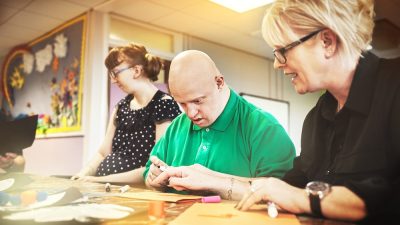From Here: Independent
To There: Autonomous
Perspective
In the field of intellectual and developmental disabilities (IDD), “independence” has often been held up as the ultimate goal, measuring success by how much a person can do without help. But independence is an odd concept, who truly lives without assistance?
Most of us rely on tools, technology, and other people every single day. I can’t wake up without an alarm clock. I can’t keep track of my schedule without a calendar reminder. I need assistive technology to navigate my dayand so do you. This is called interdependence, and it’s a reality for everyone, not just those receiving formal support.
When we make independence the destination, we risk creating barriers by requiring people to master certain skills before they can pursue what matters to them. Autonomy offers a different path. It’s the freedom to make choices, direct one’s life, and have the right supports in place, whether that’s assistive technology, other people, or both.
Shifting from independence to autonomy means recognizing that doing something “alone” isn’t the prize, living life on one’s own terms is. Our role becomes walking alongside people to remove barriers with them so they can live the life they choose, now.
From “Independent First” to “Life First”
In an “independent first” model, skill mastery often becomes a prerequisite to participation in meaningful activities.
- Independent-first: “We’ll work on tying your shoes before you start going out into the community.”
- Life-first: “You want to join a community art class? Great! Let’s get your shoes on, and I’ll teach you to tie them on the way out the door.”
In the “life-first” mindset, autonomy takes center stage, and skills develop naturally in the context of doing things that matter.
Skills and Habits
To move from independence to autonomy, we can:
- Write goals that support autonomy. Instead of “In order to increase independence,” try “in order to increase decision making skills, John will….” or “in order to increase self determination, John will experience 3 new foods, activities, hobbies…etc.”
- Embed skill-building into meaningful activities. Teaching happens in real-life moments, not isolated simulations. Remember the maxim… People learn, grow and develop as a result of participating in meaningful life activities with appropriate support.
- Treat barriers as shared challenges. Ask, “What’s in the way, and how can we remove it together?”
- Normalize interdependence. Everyone needs support…technology and relationships, to live their lives. Independence is impossible in the 21st century
- Identify and integrate with natural supports. Friends, family, neighbors, community resources
- Honor preferences and choices. True autonomy includes the freedom to make decisions others might not choose for you.
Motivation
When we embrace autonomy, we stop pretending there’s a divide between “independent” people and “dependent” people. We acknowledge that we all rely on each other in different ways and that’s not a weakness, it’s a shared human truth.
For the people we support, autonomy means more than checking off skill lists, it means living a life shaped by their choices. For staff, it means participating in moments that truly matter, which fuels purpose and reduces burnout. When we align our work with what people actually want, we create a culture of possibility rather than limitation.
Leadership
Leaders can accelerate the shift from independence to autonomy by:
- Redefining success. Make autonomy, choice, and quality of life, not skill checklists the primary measure of effective support.
- Modeling interdependence. Share openly about the supports, tools, and people they rely on in their own lives.
- Embedding values into training. Ensure staff understand that autonomy is about control over one’s life, not doing everything alone.
- Empowering flexibility. Give staff the freedom and resources to prioritize “life first” moments, even if it means changing the plan in the moment.
- Celebrating barrier removal. Recognize and reward examples of staff supporting people in living the life they choose, regardless of how much assistance is needed.
When leaders normalize interdependence and frame autonomy as the goal, they help create a culture where people can live fuller, freer lives.
The One Thing
Regardless of where you are on this journey from here to there, may we all say to ourselves on a daily basis…
“Today I choose, in my role, to assist people in getting their needs met.”



